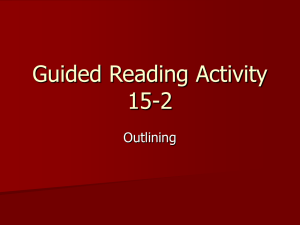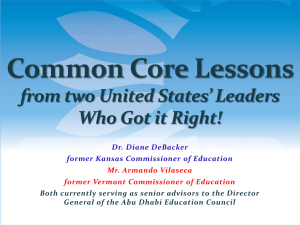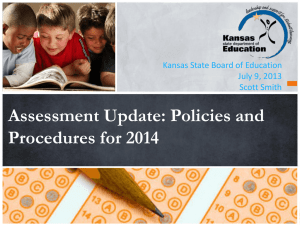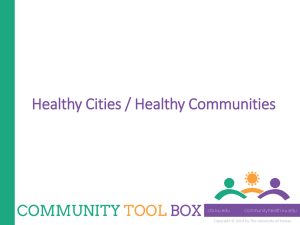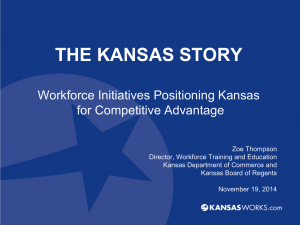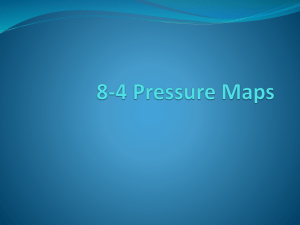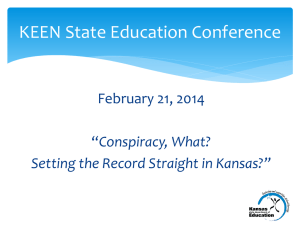Next Generation Assessments in Kansas
advertisement
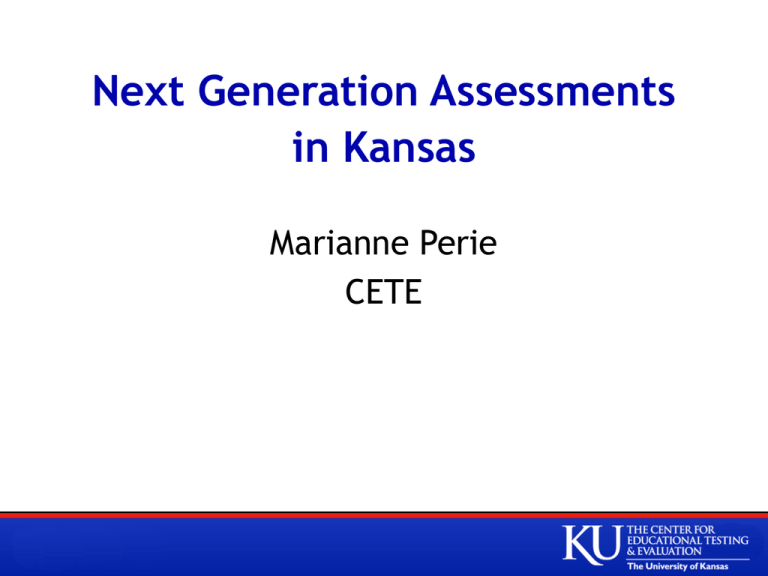
Next Generation Assessments in Kansas Marianne Perie CETE Everything is changing (We are taking suggestions on naming this new assessment!) But how much is changing, really? Transition assessment in Spring 2014 is the same as we have always planned Spring of 2015, when we would have had SBAC for the first time, we will have an enhanced Kansas assessment. By Spring of 2016, we will be very close to where we would have been with SBAC with difference due to choices made in Kansas. Spring 2014 Transition Assessment o Delivered on KITE o Aligned with Kansas College and Career Ready Standards for math, reading, and writing conventions o Follows similar blueprint to SBAC o Machine-scorable items only –No performance task –No writing prompt –No listening items New Development in 2014–2015 The transitional test will serve as the backbone for the new Kansas College and Career Ready Assessment Enhancements o Listening section o Writing prompt o Math performance tasks Spring 2015 The core machine-scorable part of the test will be parallel to what was administered in 2014, but we will refresh the item pool. We will field test the enhancements. Accountability for 2015 will be based on the core portion of the test. Schools and districts will receive feedback on the field-test portions to help gauge student readiness on the full set of standards. Summer 2015 After analyzing the field-test items, we will create the best form possible that includes all features of our future assessment. We will set new achievement standards (cut scores and performance level descriptors) based on that form. Using those new cut scores, we will set new AMOs and communicate the new targets to schools and districts. Spring 2016 Now we have a fully enhanced test that covers all of the Kansas College and Career Ready Standards. We should also have sufficient numbers of items to make the test adaptive this year as well. Adaptivity We are considering stage adaptivity rather than item adaptivity that SBAC uses. Benefits o More reliable estimates o Targets assessment to student level o Requires fewer items than item-level Model of a Stage Adaptive Test Summary Spring 2014 Core machine-scorable items aligned with KCCRS Spring 2015 Core machine-scorable items aligned with KCCRS Spring 2016 Core machine-scorable items aligned with KCCRS Math Performance Task Essay Listening Items Complete enhancements (performance task, essay, listening items) Adaptivity Kansas Fingerprints We want Kansas educator and stakeholder fingerprints all over these new assessments o Teachers –Design decisions –Item writing –Item reviewing –Rangefinding –Scoring Kansas Stakeholders Administrators o Support teacher involvement o Voice in report decisions o Cross-content development Kansas Board of Regents o High school — we want to ensure that tests truly predict college readiness o Will be involved in design and review of assessments and setting cut scores Full Kansas Assessment Program Summative assessment o ELA (complete in 2016) o Math (complete in 2016) o History/government (complete in 2017) o Science (complete in 2017) Formative tools o Really more like sample items now o Developing capacity for teachers to build test forms using item pool. o In 2016, we can start building true formative, instructionally-embedded tests. – Will include science and H/G Things to Consider Essay o Covers both ELA and Science or History/Government standards o Students in grades 4, 7, and 11 would only need to write one essay aligned to both History/government and literacy standards o Two rubrics provide two scores—one for each test o Same idea for science Example Students watch “I have a dream” and read an essay by Malcolm X. They are then asked to write an essay comparing and contrasting the two approaches to the civil rights movement. They may be asked to define and give examples of civil disobedience and discuss its efficacy. Writing Standards (G11) Write informative/explanatory texts, including the narration of historical events, scientific procedures/ experiments, or technical processes.. a. Introduce a topic clearly, previewing what is to follow; organize ideas, concepts, and information, using strategies such as definition, classification, comparison/contrast, and cause/effect; include formatting (e.g., headings), graphics (e.g., charts, tables), and multimedia when useful to aiding comprehension. b. Develop the topic with relevant facts, definitions, concrete details, quotations, or other information and examples. c. Use appropriate transitions to create cohesion and clarify the relationships among ideas and concepts. d. Use precise language and domain-specific vocabulary to inform about or explain the topic. e. Establish and maintain a formal style and objective tone. f. Provide a concluding statement or section that follows from and supports the information or explanation presented. Kansas History/Government Standards High school: Civil rights, social change Standard # 3: Societies are shaped by beliefs, ideas, and diversity. o 3.1 The student will recognize and evaluate significant beliefs, contributions, and ideas of the many diverse peoples and groups and their impact on individuals, communities, states, and nations. o 3.2 The student will draw conclusions about significant beliefs, contributions, and ideas, analyzing the origins and context under which these competing ideals were reached and the multiple perspectives from which they come. Things to consider (2) Adaptivity in writing prompt and performance task. o SBAC planned to have writing prompts and performance tasks written to three different levels of difficulty. The first part of the test would determine which writing prompt/performance task the student received. o Should we do the same? Would two levels be sufficient? Things to consider (2) Scoring o With a writing prompt and math performance task, we will have student responses that need to be scored by hand. o We would like teachers to be involved in scoring o What is the best model? Scoring models Fully distributed scoring o Teachers score on the computer using KITE. An independent activity. School or regional based scoring o Teachers score as a group and enter scores later Scoring center o Only a few teachers come to Lawrence for several days to score all student papers. Things to consider (3) Weighting the essay and performance task o What are your thoughts as to how much weight the essay should have on the ELA score or the math performance task should have on the math test? MC items are worth one point each. TE items can be worth up to 3 points each. o Math core is worth 60 points o ELA core is worth 57-71 points, depending on the grade. Things to consider (4) Listening requires headphones and additional caching Districts and schools will need to purchase headphones for every student or ask students to bring in their own (think ear buds) Streaming audio will put a huge load on the system, so you will need to work with IT to prepare for that in 2014–2015. How can KSDE and CETE prepare for this load? Things to consider (5) Number of performance levels USED requires three: Proficient, one above and one below SBAC has four; PARCC has five Kansas has traditionally used five Considering four: o Academic warning o Approaching standard o Meeting standard o Exceeding standard Would other levels be useful? Where and why? Next Steps Q and A Discussion Discussion Topics 1. Double counting essays 2. Scoring 3. Weighting the essay and math performance task 4. Streaming audio—bandwidth and caching issues 5. Number of performance levels



